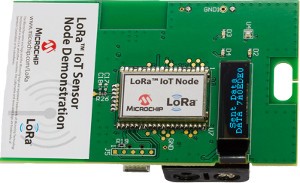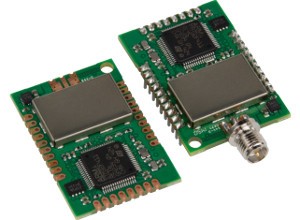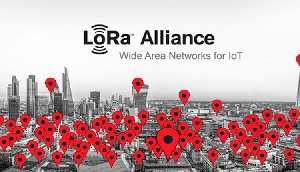With the growing interest in low-power wide-area wireless networks for Internet-of-Things and M2M applications, Microchip Technology has been rolling out a number of wireless solutions based on radio technologies such as LoRa – addressing requirements such as long-range connectivity, strong energy efficiency for long battery life, and low hardware cost to enable high-volume deployments.
LoRa is a wireless technology developed by Semtech Corporation, which utilises spread-spectrum modulation in sub-gigahertz UHF bands to enable wireless network connectivity over very long distances, with ranges on the order of 10 kilometres. This allows for extremely strong energy efficiency enabling wireless end-nodes that can operate on battery power for up to 10 years. LoRa networks also offer very high network capacity, with up to a million network nodes, high robustness, and localisation capability.
LoRa radio technology is ideally suited for battery-operated sensors, smart-city technologies, home and building automation, smart agriculture, wireless sensor networks, industrial automation technologies, and other similar M2M and Internet-of-Things applications where efficient battery use is important and network nodes may be separated over wide areas.
Microchip’s LoRa technology solutions are long-range, low-power solutions for network end nodes in IoT or M2M applications, and they’re ready to run out-of-the-box, with easy setup and configuration.
With the complete LoRaWAN protocol and RF regulatory certifications such as FCC certification provided for their modules, Microchip’s LoRa modules and solutions reduce time-to-market and reduce development costs for your connected, wireless products.
The LoRaWAN protocol is a low-power, wide-area networking (LPWAN) specification which complements LoRa technology, particularly aimed at wireless, battery-operated devices in regional, national or global networks.
LoRaWAN aims to address key requirements of M2M and Internet-of-Things applications, such as bidirectional communication, mobility, strong security, and localisation services.
The LoRaWAN protocol implements several layers of security features to ensure a high level of encryption and security is maintained across the entire embedded network. For example, a unique network session key ensures security at the network server level and a separate application session key, which is unique and also specific to a given end-node device, provides an extra layer of security at the application server level.
LoRaWAN aims to provide seamless interoperability between smart, LoRa-networked IoT “things” of different types, from different manufacturers, without the need for complex local installations.
Along with its advantages in long-range connectivity and power efficiency, this is just one of the ways that LoRa and LoRaWAN technology is aimed at further enabling the Internet of Things.
Microchip’s LoRa modules and transceiver solutions aim to provide a flexible, cost-effective platform for the creation of powerful wireless IoT solutions and products to meet customers’ needs.
Although these LoRa solutions from Microchip can be used alongside microcontrollers and components from other vendors, these devices and their supporting software examples and documentation are designed to be particularly complementary to Microchip’s popular PIC microcontrollers.
Microchip helps make it easy to build LoRa networks by providing almost-complete end-device modules that are certified for FCC and similar RF regulatory agencies. These LoRaWAN-equipped modules make it easy to connect to any LoRa Alliance certified gateway, from Actility, Cisco or Kirlink for example, and to connect to LoRa network services such as those provided by Actility or IBM.
The Microchip RN2483 LoRa module is a compact surface-mounted module which provides a built-in microcontroller, 14 GPIO pins, onboard ADC, a serial EEPROM for 64-bit MAC addressing, and the analog front end and RF matching transceiver for the transceiver.
These features integrated into the hardware module mean that an additional microcontroller may not be needed in many applications, and that no special RF design or layout expertise is needed to get you started building and deploying LoRa networks and products.

The LoRa radio in the RN2483 operates in the sub-gigahertz spectrum at either 433 MHz or 868MHz, making it compatible with different spectrum requirements across all international markets. These LoRa transceivers feature a very strong receive sensitivity of -148dBm, enabling connectivity over extremely long distances, and forward error correction is also implemented, helping to improve immunity to interference.
A unique spread-spectrum modulation scheme is used, helping to enable maximum range and maximum network capacity with minimum power consumption.
The RN2483 implements the LoRaWAN Class A protocol, enabling seamless connectivity to any LoRaWAN-compliant network infrastructure, whether public or privately deployed. It is the first LoRa module on the market to pass certification testing from the LoRa Alliance.
This module is specifically designed to make it easy to get started, accelerating your development and time to market. It is certified to the LoRaWAN 1.0 specification, ensuring that designers can quickly and easily integrate their edge-node devices into any LoRaWAN 1.0 compliant LoRaWAN network.
And this is where the LX Group us ready to work with you. We have end-to-end experience and demonstrated results in the entire process of IoT product development, and we’re ready to help bring your existing or new product ideas to life. Getting started is easy – click here to contact us, telephone 1800 810 124, or just keep in the loop by connecting here.
LX is an award-winning electronics design company based in Sydney, Australia. LX services include full turnkey design, electronics, hardware, software and firmware design. LX specialises in IoT embedded systems and wireless technologies design.
Published by LX Pty Ltd for itself and the LX Group of companies, including LX Design House, LX Solutions and LX Consulting, LX Innovations.


 The latter is more flexible, but because it requires the radio receiver to be kept online listening for new downlink messages all the time, this is the most power-inefficient mode compared to the former scenarios where the radio can be powered down. This is another way that the LoRaWAN protocol helps to maintain strong power efficiency in the endpoint devices.
The latter is more flexible, but because it requires the radio receiver to be kept online listening for new downlink messages all the time, this is the most power-inefficient mode compared to the former scenarios where the radio can be powered down. This is another way that the LoRaWAN protocol helps to maintain strong power efficiency in the endpoint devices.